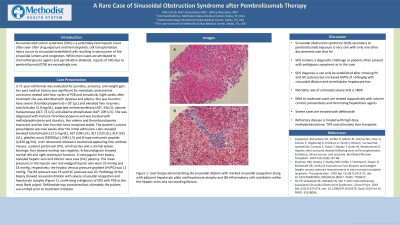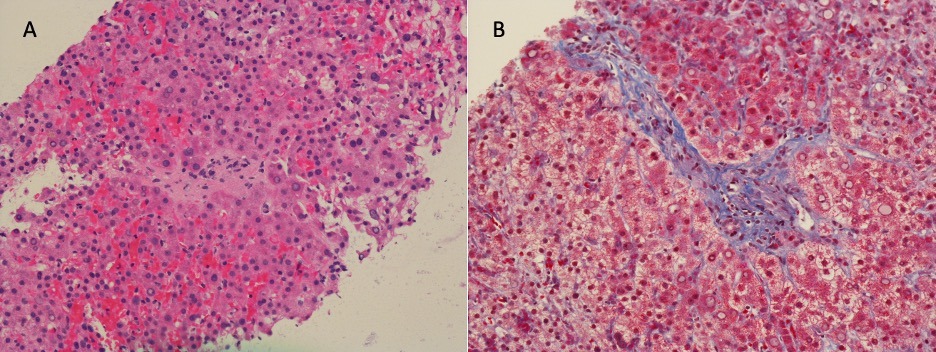Tuesday Poster Session
Category: Liver
P3926 - A Rare Case of Sinusoidal Obstruction Syndrome After Pembrolizumab Therapy
Tuesday, October 24, 2023
10:30 AM - 4:00 PM PT
Location: Exhibit Hall

Has Audio

Dillon Drab
Methodist Dallas
Dallas, TX
Presenting Author(s)
Dillon Drab, 1, David S. Braun, MD2, Jeffrey Weinstein, 3
1Methodist Dallas, Dallas, TX; 2Methodist Dallas Medical Center, Dallas, TX; 3Dallas Methodist, Dallas, TX
Introduction: Sinusoidal obstruction syndrome (SOS) is a potentially fatal hepatic insult often seen after drug exposure and hematopoietic cell transplantation. Injury occurs to sinusoidal endothelial cells resulting in obstruction of the sinusoidal lumens and congestion. While most cases are attributed to chemotherapeutic agents and pyrrolizidine alkaloids, reports of SOS due to pembrolizumab (PZB) are exceedingly rare.
Case Description/Methods: A 71-year-old female with metastatic endometrial carcinoma was treated with four cycles of PZB and Lenvatinib. Eight weeks after treatment she was admitted with dyspnea, edema. She was found to have severe thrombocytopenia (6 x 103 /µL) and elevated liver tests: total bilirubin (2.0 mg/dL), aspartate aminotransferase (AST; 24U/L), alanine transaminase (ALT; 73 U/L) and alkaline phosphatase (ALP; 209 U/L). She was diagnosed with immune thrombocytopenia and was treated with methylprednisolone and diuretics. Her edema and thrombocytopenia improved and her liver function tests remained stable. Two weeks later she was admitted with new onset jaundice, anasarca and weight gain. Labs revealed elevated bilirubin (12.5 mg/dL), AST (198 U/L), ALT (110 U/L), ALP (525 U/L), platelet count of 32 x 103 /µL, INR of 1.5, BNP of 4,4200 pg/mL. Liver ultrasound showed a coarsened liver without masses, a patent portal vein (PV), small ascites and a normal spleen. Serologic workup for liver disease was negative. Echocardiogram showed normal left and right ventricular function. A transjugular liver biopsy revealed patent hepatic veins and inferior vena cava (IVC) with mean pressure measurements (in mmHg) of 19 in the right atrium, 20 in the IVC, 22 in the hepatic vein, 33 wedged hepatic vein with a hepatic venous pressure gradient (HVPG) of 11; pathology showed sinusoidal dilation with severe sinusoidal congestion and hepatocyte atrophy (Figure 1), consistent with a SOS with PZB as the most likely culprit. Defibrotide was considered but ultimately the patient succumbed prior to treatment initiation.
Discussion: This is the second documented case of SOS after PZB exposure. SOS remains a diagnostic challenge as patients often present with ambiguous symptoms. Diagnosis is established by exhibiting PV and IVC patency, HVPG of >10mmHg, sinusoidal dilation and centrilobular hepatocyte loss. Mild to moderate case are treated supportively while severe cases are treated with defibrotide. The mortality of untreated severe SOS is > 80%.

Disclosures:
Dillon Drab, 1, David S. Braun, MD2, Jeffrey Weinstein, 3. P3926 - A Rare Case of Sinusoidal Obstruction Syndrome After Pembrolizumab Therapy, ACG 2023 Annual Scientific Meeting Abstracts. Vancouver, BC, Canada: American College of Gastroenterology.
1Methodist Dallas, Dallas, TX; 2Methodist Dallas Medical Center, Dallas, TX; 3Dallas Methodist, Dallas, TX
Introduction: Sinusoidal obstruction syndrome (SOS) is a potentially fatal hepatic insult often seen after drug exposure and hematopoietic cell transplantation. Injury occurs to sinusoidal endothelial cells resulting in obstruction of the sinusoidal lumens and congestion. While most cases are attributed to chemotherapeutic agents and pyrrolizidine alkaloids, reports of SOS due to pembrolizumab (PZB) are exceedingly rare.
Case Description/Methods: A 71-year-old female with metastatic endometrial carcinoma was treated with four cycles of PZB and Lenvatinib. Eight weeks after treatment she was admitted with dyspnea, edema. She was found to have severe thrombocytopenia (6 x 103 /µL) and elevated liver tests: total bilirubin (2.0 mg/dL), aspartate aminotransferase (AST; 24U/L), alanine transaminase (ALT; 73 U/L) and alkaline phosphatase (ALP; 209 U/L). She was diagnosed with immune thrombocytopenia and was treated with methylprednisolone and diuretics. Her edema and thrombocytopenia improved and her liver function tests remained stable. Two weeks later she was admitted with new onset jaundice, anasarca and weight gain. Labs revealed elevated bilirubin (12.5 mg/dL), AST (198 U/L), ALT (110 U/L), ALP (525 U/L), platelet count of 32 x 103 /µL, INR of 1.5, BNP of 4,4200 pg/mL. Liver ultrasound showed a coarsened liver without masses, a patent portal vein (PV), small ascites and a normal spleen. Serologic workup for liver disease was negative. Echocardiogram showed normal left and right ventricular function. A transjugular liver biopsy revealed patent hepatic veins and inferior vena cava (IVC) with mean pressure measurements (in mmHg) of 19 in the right atrium, 20 in the IVC, 22 in the hepatic vein, 33 wedged hepatic vein with a hepatic venous pressure gradient (HVPG) of 11; pathology showed sinusoidal dilation with severe sinusoidal congestion and hepatocyte atrophy (Figure 1), consistent with a SOS with PZB as the most likely culprit. Defibrotide was considered but ultimately the patient succumbed prior to treatment initiation.
Discussion: This is the second documented case of SOS after PZB exposure. SOS remains a diagnostic challenge as patients often present with ambiguous symptoms. Diagnosis is established by exhibiting PV and IVC patency, HVPG of >10mmHg, sinusoidal dilation and centrilobular hepatocyte loss. Mild to moderate case are treated supportively while severe cases are treated with defibrotide. The mortality of untreated severe SOS is > 80%.

Figure: Figure 1: Liver biopsy demonstrating (A) sinusoidal dilation with marked sinusoidal congestion along with adjacent hepatocyte plate and hepatocyte atrophy and (B) inflammatory cells and debris within the hepatic veins and surrounding fibrosis.
Disclosures:
Dillon Drab indicated no relevant financial relationships.
David Braun indicated no relevant financial relationships.
Jeffrey Weinstein indicated no relevant financial relationships.
Dillon Drab, 1, David S. Braun, MD2, Jeffrey Weinstein, 3. P3926 - A Rare Case of Sinusoidal Obstruction Syndrome After Pembrolizumab Therapy, ACG 2023 Annual Scientific Meeting Abstracts. Vancouver, BC, Canada: American College of Gastroenterology.
